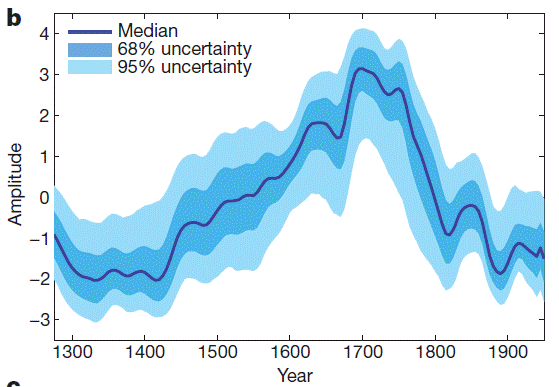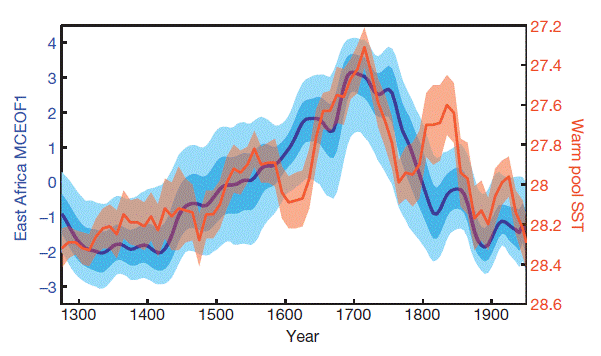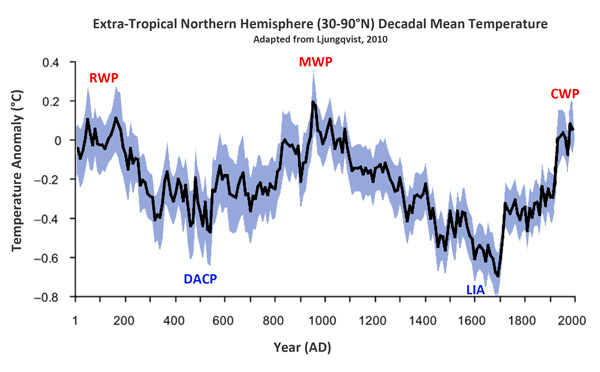Sebastian Lüning and Fritz Vahrenholt’s Die kalte Sonne site recently posted an article about the East African drought, which, as it turns out, is all part of a natural cycle.
================================================
New Study in Nature: East African Drought Trend Part of a Natural Cycle
By Sebastian Lüning and Fritz Vahrenholt
(Translated, edited by P Gosselin)

Figure 1: Moisture development of East Africa over the past 700 years. Source: Tierney et al. 2013.
East Africa has gotten drier over the last decades, suffering from drought. Those responsible for this misery were quickly found: It had to be man. His rising CO2 emissions must have irreversibly damaged the East African climate, and driven the rains off for good. This is pretty much how many environmental and aid organizations have been arguing, e.g. Aktion Deutschland Hilft or Greenpeace. Of course, you don’t have to be a marketing expert or psychologist to see the real intentions of these accusations. With feelings of guilt, donations come pouring in.
Now a new publication in the journal Nature casts serious doubt on the supposed man-made East African drought assumption. US scientists from Woods Hole Oceanographic Institution and Lamont-Doherty Earth Observatory, led by Jessica Tierney, have taken a closer look at moisture trends in East Africa and have uncovered a surprise. Using geological reconstructions, the scientists were indeed able to confirm that East Africa has dried out during the past decade. However, the group also succeeded in reconstructing the data all the way back to the year 1300 (See Figure 1 above).
As Figure 1 shows, the drought of the last decade is simply all part of a broader natural cycle that has been occurring over hundreds of years. Contrary to what was assumed earlier, the drying out did not first begin in the second half of the 20th century, but already at the end of the 18th century. A pronounced wet period prevailed in East Africa between 1680 and 1765 (Figure 1), which corresponds to the Little Ice Age – a time when global mean temperature was more than 1°C colder than today. Interestingly, East Africa was just as dry back in the 14th and 15th centuries as it is today. Clearly CO2 could not have been responsible for that.
Therefore Jessica Tierney and her team started looking for a natural driver for East Africa’s moisture development. They compared the drought data with the temperature development in the Indian Ocean. Lo and behold: both curves showed a high degree of similarity. Obviously the rain in East Africa is driven significantly by the Indian Ocean. Whenever the India Ocean is cool, the rains in East Africa increase. And when the Indian Ocean is warm, the rains become more seldom (see Figure 2):

Figure 2: Moisture in East Africa (blue curve) and sea surface temperature of the Makassar Strait (red curve; cold up, warm down). Source: Tierney et al. 2013.
In turns out that the temperature curve of the Makassar Strait near Indonesia also closely reflects global mean temperature (Figure 3). During the Medieval Warm Period and the Modern Warm Period, drought conditions prevailed in East Africa. But wet conditions ruled during the Little Ice Age. We also know that this climatic behavior over decades and centuries happens to follow solar activity. Thus moisture development in East Africa is mainly driven by solar activity.
Unfortunately the authors of this Nature study “forgot” to mention it – even though it’s made obvious by the data. The results are no surprise because numerous other studies from different parts across the world show the same distinct patterns, for example: here, here, here, and here, just to name a few from many.

Figure 3: Temperature development of the northern outer tropic hemisphere. Source: Ljungqvist 2010. RWP = Roman Warm Period, DACP = Dark Ages Cold Period, MWP = Medieval Warm Period, LIA = Little Ice Age, CWP = Current Warm Period.





So anyone out there with an IQ over 12 – you can stop your silly rain dancing.